NCERT Solutions for Class 10 Maths Chapter 3 Pair of Linear Equations in Two Variables
NCERT Solutions for Class 10 Maths Chapter 3 Pair of Linear Equations in Two Variables Ex 3.1
Ex 3.1 Class 10 Maths Question 1.
Aftab tells his daughter, “Seven years ago, I was seven times as old as you were then. Also, three years from now, I shall be three times as old as you will be”. Isn’t this interesting? Represent this situation algebraically and graphically.
Solution:


You can also download the free PDF of Ex 3.1 Class 10 Pair of Linear Equations in Two Variables NCERT Solutions or save the solution images and take the print out to keep it handy for your exam preparation.
Ex 3.1 Class 10 Maths Question 2.
The coach of a cricket team buys 3 bats and 6 balls for ₹ 3900. Later, she buys another bat and 3 more balls of the same kind for ₹1300. Represent this situation algebraically and geometrically.
Solution:
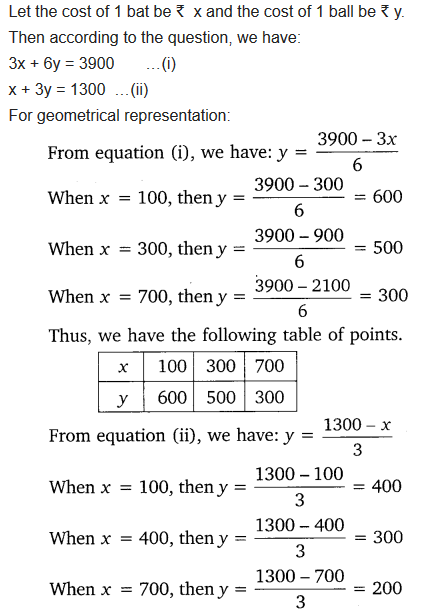

Ex 3.1 Class 10 Maths Question 3.
The cost of 2 kg of apples and 1 kg of grapes on a day was found to be ₹160. After a month, the cost of 4 kg of apples and 2 kg of grapes is ₹300. Represent the situation algebraically and geometrically.
Solution:


Class 10 Maths Pair of Linear Equations in Two Variables Mind Map
System of a Pair of Linear Equations in Two Variables
An equations of the form Ax + By + C = 0 is called a linear equation in two variables x and y where A, B, C are real numbers.
Two linear equations in the same two variables are called a pair of linear equations in two variables. Standard form of linear equations in two variables.
a1x + b1y + c1 = 0, a2x + b2y + c1 = 0
where a1, a2, b1, b2, c1, c2 are real numbers such that
![]()
Representation of Linear Equation In Two Variables
Every linear equation in two variables graphically represents a line and each solution (x, y) of a linear equation in two variables, ax + by + c = 0, corresponds to a point on the line representing the equation, and vice versa.
Ploting Linear Equation in Two Variables on the Graph
There are infinitely many solutions of each linear equation. So, we choose at least any two values of one variable & get the value of other variable by substitution, i.e; Consider; Ax + By + C = 0 We can write the above linear equation as:
![]()
Here, we can choose any values of x & can find corresponding values of y.
After getting the values of (x, y) we plot them on the graph thereby getting the line representing Ax + By + C = 0.
Method of Solution of a Pair of Linear Equations in Two Variables
Coordinate of the point (x, y) which satisfy the system of pair of linear equations in two variables is the required solution. This is the point where the two lines representing the two equations intersect each other.
There are two methods of finding solution of a pair of Linear equations in two variables.
(1) Graphical Method : This method is less convenient when point representing the solution has non-integral co-ordinates.
(2) Algebraic Method : This method is more convenient when point representing the solution has non-integral co-ordinates.
This method is further divided into three methods:
(i) Substitution Method,
(ii) Elimination Method and
(iii) Cross Multiplication Method.
Consistency and Nature of the Graphs
Consider the standard form of linear equations in two variables.
a1x + b1y + C1 = 0; a2x + b2y + c2 = 0
While solving the above system of equation following three cases arise.
(i) If a1/a2≠b1/b2; system is called consistent, having unique solution and pair of straight lines representing the above equations intersect at one point only
(ii) If a1/a2=b1/b2=c1/c2 ; system is called dependent and have infinetly many solution. Pair of lines representing the equations coincide.
(iii) If a1/a2=b1/b2≠c1/c2; system is called inconsistent and has no solution. Pair of lines representing the equations are parallel or do not intersect at any point.

Algebraic Method of Solution
Consider the following system of equation
a1x + b1y + c1 =0; a2x + b2y + c1 =0
There are following three methods under Algebraic method to solve the above system.
(i) Substitution method
(a) Find the value of one variable, say y in terms of x or x in terms of y from one equation.
(b) Substitute this value in second equation to get equation in one variable and find solution.
(c) Now substitute the value/solution so obtained in step (b) in the equation got in step (a).
(ii) Elimination Method
(a) If coefficient of any one variable are not same in both the equation multiply both the equation with suitable non-zero constants to make coefficient of any one variable numerically equal.
(b) Add or subtract the equations so obtained to get equation in one variable and solve it.
(c) Now substitute the value of the variable got in the above step in either of the original equation to get value of the other variable.
(iii) Cross multiplication method
For the pair of Linear equations intwo variables:
a1x + b1y + C1 = 0
a2x + b2y + c2 = 0
Consider the following diagram.

Solve it to get the solution, provided a1b2 – a2b1 ≠ 0
Equations Reducible to a Pair of Linear Equations in Two Variables
Sometimes pair of equations are not linear (or not in standard form), then they are altered so that they reduce to a pair of linear equations in standard form.
For example;

Here we substitute 1/x = p & \frac{1}{y} = q, the above equations reduces to:
a1p + b1q = c1 ; a2p – b2q = c2
Now we can use any method to solve them.
NCERT Solutions for Class 10 Maths Chapter 3 Pair of Linear Equations in Two Variables Ex 3.2
NCERT Solutions for Class 10 Maths Chapter 3 Pair of Linear Equations in Two Variables Ex 3.2 are part of NCERT Solutions for Class 10 Maths. Here we have given NCERT Solutions for Class 10 Maths Chapter 3 Pair of Linear Equations in Two Variables Exercise 3.2
Ex 3.2 Class 10 Maths Question 1.
Form the pair of linear equations of the following problems and find their solutions graphically:
(i) 10 students of class X took part in a Mathematics quiz. If the number of girls is 4 more than the number of boys, find the number of boys and girls who took part in the quiz.
(ii) 5 pencils and 7 pens together cost ₹50, whereas 7 pencils and 5 pens together cost ₹46. Find the cost of one pencil and that of one pen.
Solution:



Ex 3.2 Class 10 Maths Question 2.
On comparing the ratios a1/a2, b1/b2
and c1/c2 , find out whether the lines representing the following pairs of linear equations intersect at a point, are parallel or coincident:
(i) 5x – 4y + 8 = 0, 7x + 6y – 9 = 0
(ii) 9x + 3y + 12 = 0, 18x + 6y + 24 = 0
(iii) 6x – 3y + 10 = 0, 2x -y + 9 = 0
Solution:


Ex 3.2 Class 10 Maths Question 3.
On comparing the ratios a1/a2, b1/b2
and c1/c2, find out whether the following pairs of linear equations are consistent, or inconsistent:
~
Solution:


Ex 3.2 Class 10 Maths Question 4.
Which of the following pairs of linear equations are consistent/inconsistent? If consistent, obtain the solution graphically.
(i) x + y = 5, 2x + 2y = 10
(ii) x-y – 8, 3x – 3y = 16
(iii) 2x + y – 6 = 0, 4x – 2y – 4 = 0
(iv) 2x – 2y – 2 = 0, 4x – 4y – 5 = 0
Solution:





Ex 3.2 Class 10 Maths Question 5.
Half the perimeter of a rectangular garden, whose length is 4 m more than its width is 36 m. Find the dimensions of the garden graphically.
Solution:


Ex 3.2 Class 10 Maths Question 6.
Given the linear equation 2x + 3y – 8 = 0, write another linear equation in two variables such that the geometrical representation of the pair so formed is:
(i) intersecting lines
(ii) parallel lines
(iii) coincident lines
Solution:



Ex 3.2 Class 10 Maths Question 7.
Draw the, graphs of the equations x – y + 1 = 0 and 3x + 2y – 12 = 0. Determine the coordinates of the vertices of the triangle formed by these lines and the x-axis, and shade the triangular region.
Solution:

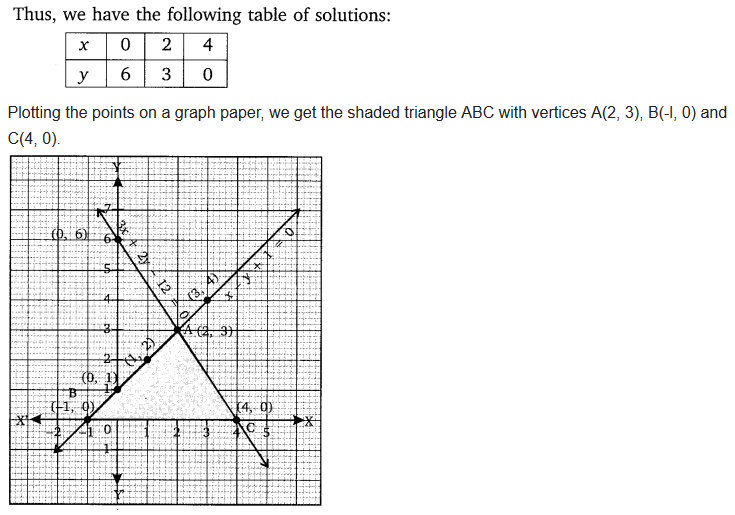
NCERT Solutions for Class 10 Maths Chapter 3 Pair of Linear Equations in Two Variables Ex 3.3
NCERT Solutions for Class 10 Maths Chapter 3 Pair of Linear Equations in Two Variables Ex 3.3 are part of NCERT Solutions for Class 10 Maths. Here we have given NCERT Solutions for Class 10 Maths Chapter 3 Pair of Linear Equations in Two Variables Exercise 3.3
Ex 3.3 Class 10 Maths Question 1.
Solve the following pairs of linear equations by the substitution method:

Solution:



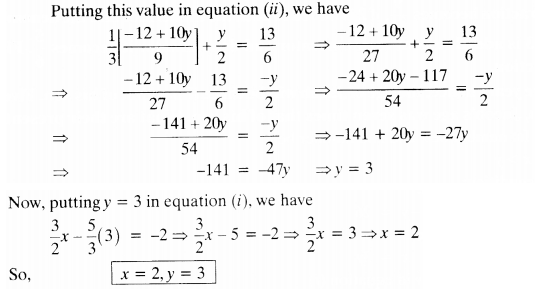
Ex 3.3 Class 10 Maths Question 2.
Solve 2x + 3y = 11 and 2x – 4y = -24 and hence find the value of’m’ for which y = mx +3.
Solution:

Ex 3.3 Class 10 Maths Question 3.
Form the pair of linear equations for the following problems and find their solution by substitution method:
(i) The difference between two numbers is 26 and one number is three times the other. Find them.
(ii) The larger of two supplementary angles exceeds the smaller by 18 degrees. Find them.
(iii) The coach of a cricket team buys 7 bats and 6 balls for ₹3800. Later, she buys 3 bats and 5 balls for ₹1750. Find the cost of each bat and each ball.
(iv) The taxi charges in a city consist of a fixed charge together with the charge for the distance covered. For a distance of 10 km, the charge paid is ₹105 and for a journey of 15 km, the charge paid is ₹155. What are the fixed charges and the charges per km? How much does a person have to pay for travelling a distance of 25 km?
(v) A fraction becomes 9/11, if 2 is added to both the numerator and the denominator. If 3 is added to both the numerator and the denominator, it becomes 5/6. Find the fraction.
(vi) Five years hence, the age of Jacob will be three times that of his son. Five year ago, Jacob’s age was seven times that of his son. What are their present ages?
Solution:





NCERT Solutions for Class 10 Maths Chapter 3 Pair of Linear Equations in Two Variables Ex 3.4
NCERT Solutions for Class 10 Maths Chapter 3 Pair of Linear Equations in Two Variables Ex 3.4 are part of NCERT Solutions for Class 10 Maths. Here we have given NCERT Solutions for Class 10 Maths Chapter 3 Pair of Linear Equations in Two Variables Exercise 3.4
Ex 3.4 Class 10 Maths Question 1.
Solve the following pairs of linear equations by the elimination method and the substitution method:

Solution:



Ex 3.4 Class 10 Maths Question 2.
Form the pair of linear equations for the following problems and find their solutions (if they exist) by the elimination method:
(i) If we add 1 to the numerator and subtract 1 from the denominator, a fraction reduces to 1. It becomes 12, if we only add 1 to the denominator. What is the fraction?
(ii) Five years ago, Nuri was thrice as old as Sonu. Ten years later, Nuri will be twice as old as Sonu. How old are Nuri and Sonu?
(iii) The sum of the digits of a two-digit number is 9. Also, nine times this number is twice the number obtained by reversing the order of the digits. Find the number.
(iv) Meena went to a bank to withdraw ₹2000. She asked the cashier to give her ₹50 and ₹100 notes only. Meena got 25 notes in all. Find how many notes of ₹50 and ₹100 she received.
(v) A lending library has a fixed charge for the first three days and an additional charge for each day thereafter. Saritha paid ₹ 27 for a book kept for seven days, while Susy paid ₹21 for the book she kept for five days. Find the fixed charge and the charge for each extra day.
Solution:

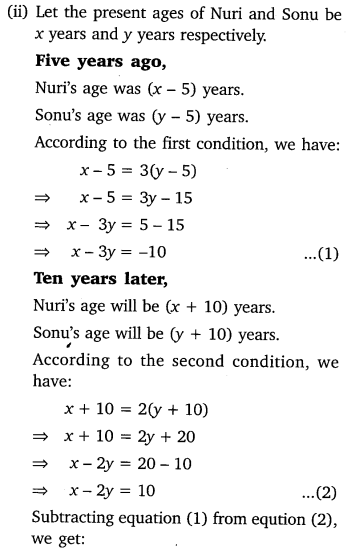

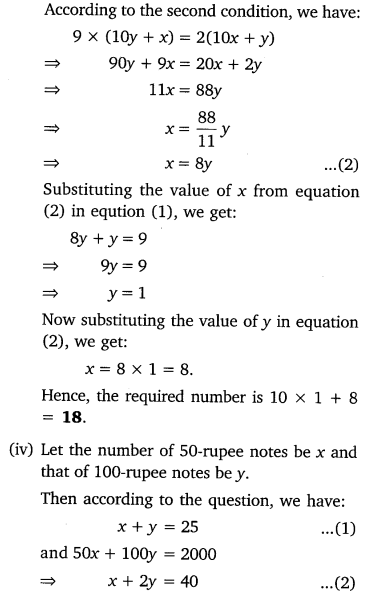


NCERT Solutions for Class 10 Maths Chapter 3 Pair of Linear Equations in Two Variables Ex 3.5
NCERT Solutions for Class 10 Maths Chapter 3 Pair of Linear Equations in Two Variables Ex 3.5 are part of NCERT Solutions for Class 10 Maths. Here we have given NCERT Solutions for Class 10 Maths Chapter 3 Pair of Linear Equations in Two Variables Exercise 3.5
Ex 3.5 Class 10 Maths Question 1.
Which of the following pairs of linear equations has unique solution, no solution or infinitely many solutions. In case there is unique solution, find it by using cross-multiplication method.
(i) x – 3y – 3 = 0, 3x – 9y – 2 = 0
(ii) 2x + y = 5, 3x + 2y = 8
(iii) 3x – 5y = 20, 6x – 10y = 40
(iv) x – 3y – 7 = 0, 3x – 3y – 15 = 0
Solution:



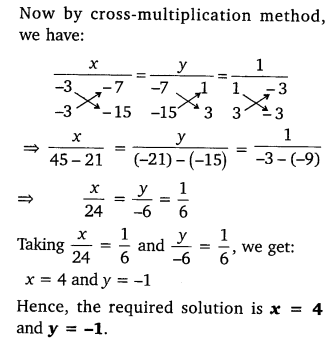
Download NCERT Solutions For Class 10 Maths Chapter 3 Pair of Linear Equations in Two Variables PDF
Ex 3.5 Class 10 Maths Question 2.
(i) For which values of a and b does the following pair of linear equations have an infinite number of solutions?
2x + 3y = 7
(a – b)x + (a + b)y = 3a + b – 2
(ii) For which value of k will the following pair of linear equations have no solution?
3x + y = 1
(2k – 1)x + (k – 1)y = (2k + 1)
Solution:

Ex 3.5 Class 10 Maths Question 3.
Solve the following pair of linear equations by the substitution and cross-multiplication methods:
8x + 5y = 9, 3x + 2y = 4
Solution:

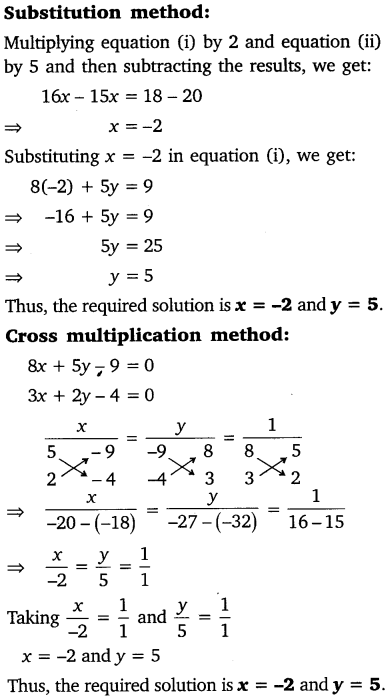
Ex 3.5 Class 10 Maths Question 4.
Form the pair of linear equations in the following problems and find their solutions (if they exist) by any algebraic method:
(i) A part of monthly hostel charges is fixed and the remaining depends on the number of days one has taken food in the mess. When a student A takes food for 20 days she has to pay ₹ 1000 as hostel charges, whereas a student B, who takes food for 26 days, pays ₹ 1180 as hostel charges. Find the fixed charges and the cost of food per day.
(ii) A fraction becomes 1/3 when 1 is subtracted from the numerator and it becomes 1/4 when 8 is added to its denominator. Find the fraction.
(iii) Yash scored 40 marks in a test, getting 3 marks for each right answer and losing 1 mark for each wrong answer. Had 4 marks been awarded for each correct answer and 2 marks been deducted for each incorrect answer, then Yash would have scored 50 marks. How many questions were there in the test?
(iv) Places A and B are 100 km apart on a highway. One car starts from A and another from B at the same time. If the cars travel in the same direction at different speeds, they meet in 5 hours. If they travel towards each other, they meet in 1 hour. What are the speeds of the two cars?
(v) The area of a rectangle gets reduced by 9 square units, if its length is reduced by units and breadth is increased by 3 units. If we increase the length by 3 units and the breadth by 2 units, the area increases by 67 square units. Find the dimensions of the rectangle.
Solution:





NCERT Solutions for Class 10 Maths Chapter 3 Pair of Linear Equations in Two Variables Ex 3.6
NCERT Solutions for Class 10 Maths Chapter 3 Pair of Linear Equations in Two Variables Ex 3.6 are part of NCERT Solutions for Class 10 Maths. Here we have given NCERT Solutions for Class 10 Maths Chapter 3 Pair of Linear Equations in Two Variables Exercise 3.6
Ex 3.6 Class 10 Maths Question 1.
Solve the following pairs of equations by reducing them to a pair of linear equations:

Solution:


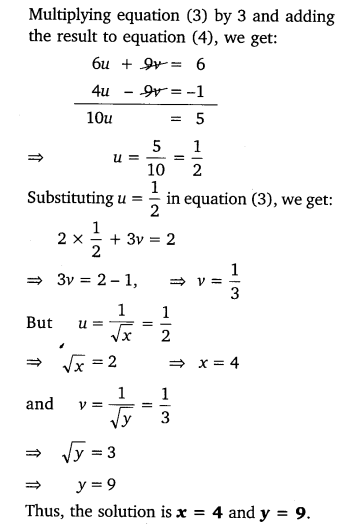









Ex 3.6 Class 10 Maths Question 2.
Formulate the following problems as a pair of linear equations and hence find their solutions:
(i) Ritu can row downstream 20 km in hours and upstream 4 km in 2 hours. Find her speed of rowing in still water and the speed of the current.
(ii) 2 women and 5 men can together finish an embroidery work in 4 days, while 3 women and 6 men can finish it in 3 days. Find the time taken by 1 woman alone to finish the work, and also that taken by 1 man alone.
(iii) Roohi travels 300 km to her home partly by train and partly by bus. She takes 4 hours if she travels 60 km by train and the remaining by bus. If she travels 100 km by train and the remaining by bus, she takes 10 minutes longer. Find the speed of the train and the bus separately.
Solution:



NCERT Solutions for Class 10 Maths Chapter 3 Pair of Linear Equations in Two Variables Ex 3.7
NCERT Solutions for Class 10 Maths Chapter 3 Pair of Linear Equations in Two Variables Ex 3.7 are part of NCERT Solutions for Class 10 Maths. Here we have given NCERT Solutions for Class 10 Maths Chapter 3 Pair of Linear Equations in Two Variables Exercise 3.7
Ex 3.7 Class 10 Maths Question 1.
The age of two friends Ani and Biju differ by 3 years. Ani’s father Dharam is twice as old as Ani and Biju is twice as old as his sister Cathy. The ages of Cathy and Dharam differ by 30 years. Find the ages of Ani and Biju.
Solution:
Let the ages of Ani and Biju be x years and y years respectively.
If Ani is older than Biju
x – y =3
If Biju is older than Ani
y – x = 3
-x + y =3 [Given]

Subtracting equation (i) from equation (ii), we get:
3x – 57
⇒ x = 19
Putting x = 19 in equation (i), we get
19-y = 3
⇒ y = 16
Again subtracting equation (iv) from equation (iii), we get
3x = 63
⇒ x = 21
Putting x = 21 in equation (iii) we get
21 -y= -3
⇒ y = 24
Hence, Ani’s age is either 19 years or 21 years and Biju’s age is either 16 years or 24 years.
Ex 3.7 Class 10 Maths Question 2.
One says, “Give me a hundred, friend! I shall then become twice as rich as you”. The other replies, “If you give me ten, I shall be six times as rich as you”. Tell me what is the amount of their (respective) capital?
Solution:
Let the two friends have ₹ x and ₹ y.
According to the first condition:
One friend has an amount = ₹(x + 100)
Other has an amount = ₹ (y – 100
∴ (x + 100) =2 (y – 100)
⇒ x + 100 = 2y – 200
⇒ x – 2y = -300 …(i)
According to the second condition:
One friend has an amount = ₹(x – 10)
Other friend has an amount =₹ (y + 10)
∴ 6(x – 10) = y + 10
⇒ 6x – 60 = y + 10
⇒ 6x-y = 70 …(ii)
Multiplying (ii) equation by 2 and subtracting the result from equation (i), we get:
x – 12x = – 300 – 140
⇒ -11x = -440
⇒ x = 40
Substituting x = 40 in equation (ii), we get
6 x 40 – y = 70
⇒ -y = 70- 24
⇒ y = 170
Thus, the two friends have ₹ 40 and ₹ 170.
Ex 3.7 Class 10 Maths Question 3.
A train covered a certain distance at a uniform speed. If the train would have been 10 km/h faster, it would have taken 2 hours less than the scheduled time. And, if the train were slower by 10 km/h, it would have taken 3 hours more than the scheduled time. Find the distance covered by the train.
Solution:
Let the original speed of the train be x km/h
and the time taken to complete the journey be y hours. ‘
Then the distance covered = xy km
Case I: When speed = (x + 10) km/h and time taken = (y – 2) h
Distance = (x + 10) (y – 2) km
⇒ xy = (x + 10) (y – 2)
⇒ 10y – 2x = 20
⇒ 5y – x = 10
⇒ -x + 5y = 10 …(i)
Case II: When speed = (x – 10) km/h and time taken = (y + 3) h
Distance = (x – 10) (y + 3) km
⇒ xy = (x – 10) (y + 3)
⇒ 3x- 10y = 30 …(ii)
Multiplying equation (i) by 3 and adding the result to equation (ii), we get
15y – 10y = 30 f 30
⇒ 5y = 60
⇒ y = 12
Putting y = 12 in equation (ii), we get
3x- 10 x 12= 30
⇒ 3x = 150
⇒ x = 50
∴ x = 50 and y = 12
Thus, original speed of train is 50 km/h and time taken by it is 12 h.
Distance covered by train = Speed x Time
= 50 x 12 = 600 km.
Ex 3.7 Class 10 Maths Question 4.
The students of a class are made to stand in rows. If 3 students are extra in a row, there would be 1 row less. If 3 students are less in a row, there would be 2 rows more. Find the number of students in the class.
Solution:
Let the number of rows be x and the number of students in each row be y.
Then the total number of students = xy
Case I: When there are 3 more students in each row
Then the number of students in a row = (y + 3)
and the number of rows = (x – 1)
Total number of students = (x – 1) (y + 3)
∴ (x – 1) (y + 3) = xy
⇒ 3x -y =3 …(i)
Case II: When 3 students are removed from each row
Then the number of students in each row = (y-3)
and the number of rows = (x + 2)
Total number of students = (x + 2) (y – 3)
∴ (x + 2) (y – 3) = xy
⇒ -3x + 2y = 6 …(ii)
Adding the equations (i) and (ii), we get
-y + 2y = 3 + 6
⇒ y = 9
Putting y = 9 in the equation (ii), we get
-3x + 18 = 6
⇒ x = 4
∴ x = 4 and y = 9
Hence, the total number of students in the class is 9 x 4 = 36.
Ex 3.7 Class 10 Maths Question 5.
In a ∆ABC, ∠C = 3 ∠B = 2(∠A + ∠B). Find the three angles.
Solution:
Let ∠A = x° and ∠B = y°.
Then ∠C = 3∠B = (3y)°.
Now ∠A + ∠B + ∠C = 180°
⇒ x + y + 3y = 180°
⇒ x + 4y = 180° …(i)
Also, ∠C = 2(∠A + ∠B)
⇒ 3y – 2(x + y)
⇒ 2x – y = 0° …(ii)
Multiplying (ii) by 4 and adding the result to equation (i), we get:
9x = 180°
⇒ x = 20°
Putting x = 20 in equation (i), we get:
20 + 4y = 180°
⇒ 4y = 160°
⇒ y = 160/40 = 40°
∴ ∠A = 20°, ∠B = 40° and ∠C = 3 x 40° = 120°.
Ex 3.7 Class 10 Maths Question 6.
Draw the graphs of the equations 5x – y = 5 and 3x – y = 3. Determine the coordinates of the vertices of the triangle formed by these lines and the y-axis.
Solution:
5x – y = 5 …(i)
3x-y = 3 …(ii)
For graphical representation:
From equation (i), we get: y = 5x – 5
When x = 0, then y -5
When x = 2, then y = 10 – 5 = 5
When x = 1, then y = 5 – 5 = 10
Thus, we have the following table of solutions:

From equation (ii), we get:
⇒ y = 3x – 3
When x = 0, then y = -3
When x = 2, then y = 6 – 3 = 3
When x = 1, then y = 3 – 3 = 0
Thus, we have the following table of solutions:

Plotting the points of each table of solutions, we obtain the graphs of two lines intersecting each other at a point C(1, 0).

The vertices of ΔABC formed by these lines and the y-axis are A(0, -5), B(0, -3) and C(1, 0).
Ex 3.7 Class 10 Maths Question 7.
Solve the following pairs of linear equations:

Solution:
(i) The given equations are
px + qy = p – q …(1)
qx – py = p + q …(2)
Multiplying equation (1) byp and equation (2) by q and then adding the results, we get:
x(p2 + q2) = p(p – q) + q(p + q)


(ii) The given equations are
ax + by = c …(1)
bx – ay = 1 + c …(2)
Multiplying equation (1) by b and equation (2) by a, we get:
abx + b2y = cb …(3)
abx + a2y = a(1+ c) …(4)
Subtracting (3) from (4), we get:


(iii) The given equations may be written as: bx – ay = 0 …(1)
ax + by = a2 + b2 …(2)
Multiplying equation (1) by b and equation (2) by a, we get:
b2x + aby = 0 ….(3)
a2x + aby = a(a2 + b2) …..(4)
Adding equation (3) and equation (4), we get:
(a2 + b2)x = a (a2 + b2) a(a2 + b2)

(iv) The given equations may be written as:
(a – b)x + (a + b)y = a2 – 2ab – b2 …(1)
(a + b)x + (a + b)y = a2 + b2 …(2)
Subtracting equation (2) from equation (1), we get:
(a – b)x – (a + b)x
= (a2 – 2ab – b2) – (a2 + b2)
⇒ x(a – b- a-b) = a2 – 2ab – b2 – a2 – b2
⇒ -2bx = -2ab – 2b2
⇒ 2bx = 2b2 + 2ab


(v) The given equations may be written as:
76x – 189y = -37 …(1)
-189x + 76y = -302 …(2)
Multiplying equation (1) by 76 and equation (2) by 189, we get:
5776x – 14364y = -2812 …(3)
-35721x + 14364y = -57078 …(4)
Adding equations (3) and (4), we get:
5776x – 35721x = -2812 – 57078
⇒ – 29945x = -59890
⇒ x = 2
Putting x = 2 in equation (1), we get:
76 x 2 – 189y = -37
⇒ 152 – 189y = -37
⇒ -189y = -189
⇒ y = 1
Thus, x = 2 and y = 1 is the required solution.
Ex 3.7 Class 10 Maths Question 8.
ABCD is a cyclic quadrilateral (see figure). Find the angles of the cyclic quadrilateral.

Solution:


Pair of Linear Equations in Two Variables Class 10 Extra Questions Maths Chapter 3
Extra Questions for Class 10 Maths Chapter 3 Pair of Linear Equations in Two Variables. According to new CBSE Exam Pattern, MCQ Questions for Class 10 Maths Carries 20 Marks.


















































Important Questions for Class 10 Maths Chapter 3 Pair of Linear Equations in Two Variables
Pair of Linear Equations in Two Variables Class 10 Important Questions Very Short Answer (1 Mark)
Question 1.
How many solutions does the pair of equations y = 0 and y = -5 have? (2013)
Solution:
y = 0 and y = -5 are Parallel lines, hence no solution.
Question 2.
If ax + by = a2 – b2 and bx + ay = 0, find the value of (x + y). (2013)
Solution:

Question 3.
For what value of k, the pair of equations 4x – 3y = 9, 2x + ky = 11 has no solution? (2017D)
Solution:
We have, 4x – 3y = 9 and 2x + ky = 11

Question 4.
Calculate the area bounded by the line x + y = 10 and both the co-ordinate axes. (2012)
Solution:
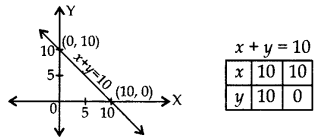
Area of triangle
= 1/2 × base × corresponding altitude
= 1/2 × 10 × 10 = 50 cm2
Pair of Linear Equations in Two Variables Class 10 Important Questions Short Answer-1 (2 Marks)
Question 5.
Find whether the following pair of linear equations is consistent or inconsistent: (2015)
3x + 2y = 8 6x – 4y = 9
Solution:

Therefore, given pair of linear equations is con-sistent.
Question 6.
Check graphically whether the pair of equations 3x – 2y + 2 = 0 and 3/2x – y + 3 = 0, is consistent. Also find the coordinates of the points where the graphs of the equations meet the Y-axis.
Solution:

By plotting the points and joining them, the lines do not intersect anywhere, i.e., they are parallel.
Therefore given pair of equations is not consistent, i.e., inconsistent.
The equation 3x – 2y + 2 = 0 meets the Y-axis at A(0,1).
The equation 3/2x – y + 3 = 0 meets the Y-axis at B(0, 3).
Question 7.
Draw the graph of
2y = 4x – 6; 2x = y + 3 and determine whether this system of linear equations has a unique solution or not.
Solution:
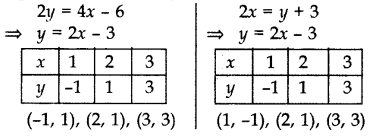

Since both the lines coincide.
Therefore infinitely many solutions.
Question 8.
Represent the following pair of equations graphically and write the coordinates of points where the lines intersect y-axis.
Solution:
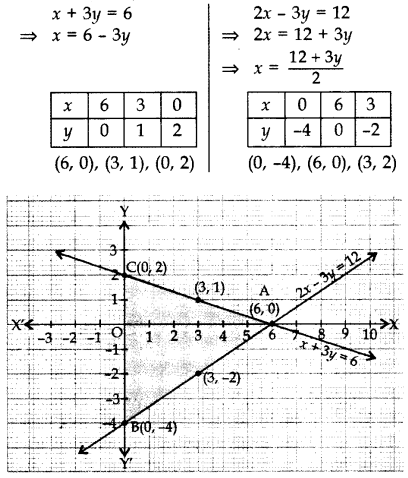
By plotting the points and joining them, the lines intersect at A (6, 0).
Line x + 3y = 6 intersects y-axis at B(0, 2) and Line 2x – 3y = 12 intersects y-axis at C(0, -4).
Pair of Linear Equations in Two Variables Class 10 Important Questions Short Answer-II (3 Marks)
Question 9.
Solve the following pair of equations for x and y: (2012)
a2/x−b2/y = 0; a2b/x+b2a/y = a + b, x ≠ 0; y ≠ 0
Solution:

Question 10.
Solve for x and y:
10/x+y+2/x−y=4;15/x+y−5/x−y=−2
x + y ≠ 0
x – y ≠ 0 (2012, 2017D)
Solution:

Question 11.
Solve the following pair of linear equations for x and y:
141x + 93y = 189;
93x + 141y = 45 (2013)
Solution:

Question 12.
Solve the following pair of linear equations for x and y: (2013)
b/ax+a/by = a2 + b2; x + y = 2ab
Solution:

Question 13.
Solve by elimination: (2014)
3x = y + 5
5x – y = 11
Solution:
We have, 3x = y + 5, and 5x – y = 11

Putting the value of x in (i), we get
3x – y = 5 ⇒ 3(3) – y = 5
9 – 5 = y ⇒ y = 4
∴ x = 3, y = 4
Question 14.
Solve by elimination: 2015
3x – y – 7
2x + 5y + 1 = 0
Solution:
3 x – y = 7 …(i)
2x + 5y = -1 -00
Multiplying equation (i) by 5 & (ii) by 1,

⇒ x = 2
Putting the value of x in (i), we have
3(2)-y = 7 ⇒ 6 – 7 = y
∴ y = -1 ∴ x = 2, y = -1
Question 15.
Solve for x and y: (2017OD)
27x + 31y = 85;
31x + 2 7y = 89
Solution:

Putting the value of ‘x’ in (i), we get
2 + y = 3 ⇒ y = 3 – 2 = 1
∴ x = 2, y = 1
Question 16.
Solve for x and y: x/a=y/b;
ax + by = a2+ b2 (2017D)
Solution:

Putting the value of x in (i), we get
b(a) – ay = 0 ⇒ ba = ay
ba/a = y ∴ b = y
∴ x = a, y = b
Question 17.
Solve: x/a+y/b = a + b; x/a2+y/b2 =2, a, b ≠ 0 (2017OD)
Solution:

Question 18.
Solve the following pair of equations: (2014)
49x + 51y = 499
51x + 49 y = 501
Solution:

Question 19.
Find the two numbers whose sum is 75 and difference is 15. (2014)
Solution:
Let the two numbers be x and y.
According to the question,
x + y = 75 …(i)
∴ x – y = ±15 …(ii)
Solving (i) and (ii), we get

Question 20.
Find the value of a and p for which the following pair of linear equations has infinite number of solutions:
2x + 3y = 7;
αx + (α + β)y = 28 (2013)
Solution:
We have, 2x + 3y = 7 and αx + (α + β)y = 28

Question 21.
Solve the following pair of linear equations by the cross multiplication method: x + 2y = 2; x – 3y = 7 (2015)
Solution:
x + 2y – 2 = 0
x – 3y – 7 = 0

Question 22.
A man earns ₹600 per month more than his wife. One-tenth of the man’s salary and l/6th of the wife’s salary amount to ₹1,500, which is saved every month. Find their incomes. (2014)
Solution:
Let wife’s monthly income = ₹x
Then man’s monthly income = ₹(x + 600)
According to the question,

Question 23.
The sum of the digits of a two digit number is 8 and the difference between the number and that formed by reversing the digits is 18. Find the number. (2015)
Solution:
Let unit and tens digit be x and y.
∴ Original number = 1x + 10y …(i)
Reversed number = 10x + 1y
According to question,
x + y = 8
⇒ y = 8 – x …(ii)
Also, 1x + 10Oy – (10x + y) = 18
⇒ x + 10y – 10x – y = 18
⇒ 9y – 9x = 18
⇒ y – x = 2 …[Dividing both sides by 9
⇒ 8 – x – x = 2 …[From (it)
⇒ 8 – 2 = 2x
⇒ 2x = 6
From (it), y = 8 – 3 = 5
From (i), Original number = 3 + 10(5) = 53
Pair of Linear Equations in Two Variables Class 10 Important Questions Long Answer (4 Marks)
Question 24.
The age of the father is twice the sum of the ages of his 2 children. After 20 years, his age will be equal to the sum of the ages of his children. Find the age of the father. (2012)
Solution:
Let the present ages of his children be x years and y years.
Then the present age of the father = 2(x + y) …(i)
After 20 years, his children’s ages will be
(x + 20) and (y + 20) years
After 20 years, father’s age will be 2(x + y) + 20
According to the Question,
⇒ 2(x + y) + 20 = x + 20 + y + 20
⇒ 2x + 2y + 20 = x + y + 40
⇒ 2x + 2y – x – y = 40 – 20
⇒ x + y = 20 …[From (i)
∴ Present age of father = 2(20) = 40 years
Question 25.
A two digit number is seven times the sum of its digits. The number formed by reversing the digits is 18 less than the given number. Find the given number. (2013)
Solution:
Let unit’s place digit be x and ten’s place digit bey.
Then original number = x + 10y
and reversed number = 10x + y
According to the Question,
x + 10y = 7(x + y)
x + 10y = 7x + 7y
⇒ 10y – 7y = 7x – x
⇒ 3y = 6x ⇒ y = 2x …(i)
(x + 10y) – (10x + y) = 18
x + 10y – 10x – y = 18
⇒ 9y – 9x = 180
⇒ y – x = 2 …[Dividing by 9
⇒ 2x – x = 2 …[From (i)
∴ x = 2
Putting the value of ‘x’ in (i), we get y = 2(2) = 4
∴ Required number = x + 10y
= 2 + 10(4) = 42
Question 26.
Sita Devi wants to make a rectangular pond on the road side for the purpose of providing drinking water for street animals. The area of the pond will be decreased by 3 square feet if its length is decreased by 2 ft. and breadth is increased by 1 ft. Its area will be increased by 4 square feet if the length is increased by 1 ft. and breadth remains same. Find the dimensions of the pond. (2014)
Solution:
Let length of rectangular pond = x
and breadth of rectangular pond = y
Area of rectangular pond = xy
According to Question,

∴Length of rectangular pond = 7 ft.
Breadth of rectangular pond = 4 ft.
Question 27.
On reversing the digits of a two digit number, number obtained is 9 less than three times the original number. If difference of these two numbers is 45, find the original number. (2014)
Solution:
Let unit’s place digit be x and ten’s place digit bey.
∴ Original number = x + 10y Reversed number = 10x + y
According to the Question,
10x + y = 3(x + 10y) – 9
⇒ 10x + y = 3x + 30y – 9
⇒ 10x + y – 3x – 30y = -9
⇒ 7x – 29y = -9 …(i)
10x + y – (x + 10y) = 45
⇒ 9x – 9y = 45
⇒ x – y = 5 …[Dividing both sides by 9
⇒ x – 5 + y …(ii)
Solving (i),
7x – 29y = -9
7(5 + y) – 29y = -9 …[From (ii)
35+ 7y – 29y = -9
-22y = -9 – 35
-22y = -44 ⇒ y = 44/22 = 2
Putting the value of y in (ii),
x = 5 + 2 = 7
∴ Original number = x + 10y
= 7 + 10(2) = 27
Question 28.
Speed of a boat in still water is 15 km/h. It goes 30 km upstream and returns back at the same point in 4 hours 30 minutes. Find the speed of the stream. 2017D
Solution:
Let the speed of the stream = x km/hr
Speed of the boat in still water = 15 km/hr
then, the speed of the boat upstream = (15 – x) km/hr
and the speed of the boat downstream = (15 + x) km/hr

∴ Speed of stream = 5 km/hr
Question 29.
The owner of a taxi company decides to run all the taxis on CNG fuel instead of petrol/diesel. The taxi charges in city comprises of fixed charges together with the charge for the distance covered. For a journey of 12 km, the charge paid is 789 and for journey of 20 km, the charge paid is ₹145.
What will a person have to pay for travelling a distance of 30 km? (2014)
Solution:
Let the fixed charges = 7x
and the charge per km = ₹y
According to the Question,

Putting the value of y in (i), we get
x + 12(7) = 89
x + 84 = 89 ⇒ x = 89 – 84 = 5
Total fare for 30 km = x + 30y = 5 + 30(7)
= 5 + 210 = ₹215
Question 30.
A boat takes 4 hours to go 44 km downstream and it can go 20 km upstream in the same time. Find the speed of the stream and that of the boat in still water. (2015)
Solution:
Let the speed of the stream = y km/hr
Let the speed of boat in still water = x km/hr
then, the speed of the boat in downstream = (x + y) km/hr
and, the speed of the boat in upstream = (x – y) km/hr

From (i), x = 11 – 3 = 8
∴ Speed of the stream, y =3 km/hr
Speed of the boat in still water, x = 8 km/hr
Question 31.
A man travels 300 km partly by train and partly by car. He takes 4 hours if the travels 60 km by train and the rest by car. If he travels 100 km by train and the remaining by car, he takes 10 minutes longer. Find the speeds of the train and the car separately. (2017D)
Solution:
Let the speed of the train = x km/hr
Let the speed of the car = y km/ hr
According to the Question,

∴ Speed of the train = 60 km/hr
and Speed of the car = 80 kn/hr
Question 32.
The owner of a taxi company decides to run all the taxis on CNG fuel instead of petrol/diesel. The taxi charges in city comprises of fixed charges together with the charge for the distance covered. For a journey of 13 km, the charge paid is ₹129 and for a journey of 22 km, the charge paid is ₹210.
What will a person have to pay for travelling a distance of 32 km? (2014 )
Solution:
Let fixed charge be ₹x and the charge for the distance = ₹y per km
According to the Question,
For a journey of 13 km,
x + 13y = 129 ⇒ x = 129 – 13y …(/)
For a journey of 22 km, x + 22y = 210 …(ii)
⇒ 129 – 13y + 22y = 210 …[From (i)
⇒ 9y = 210 – 129 = 81
⇒ 9y = 81 ⇒ y = 9
From (i), x = 129 – 13(9)
= 129 – 117 = 12
∴ Fixed charge, x = ₹12
∴ The charge for the distance, y = ₹9 per km
To pay for travelling a distance of 32 km
= x + 32y = 12 + 32(9) = 12 + 288 = ₹300
Question 33.
Solve the following pair of linear equations graphically:
x + 3y = 6 ; 2x – 3y = 12
Also find the area of the triangle formed by the lines representing the given equations with y-axis. (2012, 2015)
Solution:

By plotting points and joining them, the lines intersesct at A(6, 0)
∴ x = 6, y = 0
Line x + 3y = 6 intersects Y-axis at B(0, 2) and Line 2x – 3y = 12 intersects Y-axis at C(0, -4). Therefore, Area of triangle formed by the lines with y-axis.
Area of triangle
= 1/2 × base × corresponding altitude
= 1/2 × BC × AO = 1/2 × 6 × 6 = 18 sq. units
Question 34.
Draw the graphs of following equations:
2x – y = 1; x + 2y = 13
Find the solution of the equations from the graph and shade the triangular region formed by the lines and the y-axis. (2013)
Solution:

By plotting the points and joining them, the lines intersect at A(3,5).
∴ x = 3, y = 5
Here ∆ABC is the required triangle.
Question 35.
Draw the graphs of the equations x – y + 1 = 0 and 3x + 2y – 12 = 0. Determine the coordinates of the vertices of the triangle formed by these lines and x-axis. (2012, 2017D)
Solution:

Lines intersect at (2, 3)
∴ x = 2, y = 3
Vertices of ∆ABC are A(2, 3), B(-1, 0) and C(4, 0)
Question 36.
Amit bought two pencils and three chocolates for ₹11 and Sumeet bought one pencil and two chocolates for ₹7. Represent this situation in the form of a pair of linear equations. Find the price of one pencil and that of one chocolate graphically. (2017OD)
Solution:
Let the price of one pencil = ₹x and the price of one chocolate = ₹y.
As per the Question,

Lines intersect at (1, 3).
∴ x = 1, y = 3
Therefore the price of one pencil = ₹1 and price of one chocolate = ₹3
Question 37.
7x – 5y – 4 = 0 is given. Write another linear equation, so that the lines represented by the pair are:
(i) intersecting
(ii) coincident
(iii) parallel (2015 OD)
Solution:
7x – 5y – 4 = 0

CBSE Class 10 Maths Notes Chapter 3 Pair of Linear equations in Two Variables
- For any linear equation, each solution (x, y) corresponds to a point on the line. General form is given by ax + by + c = 0.
- The graph of a linear equation is a straight line.
- Two linear equations in the same two variables are called a pair of linear equations in two variables. The most general form of a pair of linear equations is: a1x + b1y + c1 = 0; a2x + b2y + c2 = 0
where a1, a2, b1, b2, c1 and c2 are real numbers, such that a12 + b12 ≠ 0, a22 + b22 ≠ 0. - A pair of values of variables ‘x‘ and ‘y’ which satisfy both the equations in the given system of equations is said to be a solution of the simultaneous pair of linear equations.
- A pair of linear equations in two variables can be represented and solved, by
(i) Graphical method
(ii) Algebraic method
(i) Graphical method. The graph of a pair of linear equations in two variables is presented by two lines.
(ii) Algebraic methods. Following are the methods for finding the solutions(s) of a pair of linear equations:
- Substitution method
- Elimination method
- Cross-multiplication method.
- There are several situations which can be mathematically represented by two equations that are not linear to start with. But we allow them so that they are reduced to a pair of linear equations.
- Consistent system. A system of linear equations is said to be consistent if it has at least one solution.
- Inconsistent system. A system of linear equations is said to be inconsistent if it has no solution.
CONDITIONS FOR CONSISTENCY
Let the two equations be:
a1x + b1y + c1 = 0
a2x + b2y + c2 = 0
Then,
| Relationship between coeff. or the pair of equations | Graph | Number of Solutions | Consistency of System |
| a1/a2≠b1/b2 | Intersecting lines | Unique solution | Consistent |
| a1/a2=b1/b2≠c1/c2 | Parallel lines | No solution | Inconsistent |
| a1/a2=b1/b2=c1/c2 | Co-incident lines | Infinite solutions | Consistent |
